Eastern Africa Network for Trypanosomosis (EANETT)

Human African trypanosomosis (sleeping sickness) was largely under control in the 1960s but showed a resurgence in the 1990s due to civil unrest and wars, neglected control measures and loss of drug effectiveness. Sleeping sickness is restricted to foci which do not follow national boundaries, the movement of people and domestic animals contributing to the spread of the disease.
The Network
In the absence of a large-scale international collaboration between the countries affected by sleeping sickness, in 1999, national institutions involved in trypanosomiasis and tsetse research and control in Uganda, Kenya, Sudan and Tanzania together with the Swiss TPH founded EANETT. The network aims at establishing collaboration in research, training and control of trypanosomosis, links for exchange of information and technologies through workshops, technical exchange visits, MSc and PhD programmes, and an annual conference.
Organisation
EANETT was awarded core funding from the SDC for a first phase of 3 years (2001–2003) and then a second phase, 2004–2006. During the first 3 years of operation, the network had to establish an administrative basis with a Board of Management with one representative from each member country and a secretary. The board met twice a year and an Annual Conference was held towards the end of each year to review progress and plan the following year. This annual conference evolved into a scientific meeting with scientific presentations for 2 days and an additional day for planning.
Today EANETT is a member of the WHO group ‘Sleeping Sickness Treatment and Drug Resistance’ and the International Scientific Council for Trypanosomiasis Research and Control (ISCTRC).